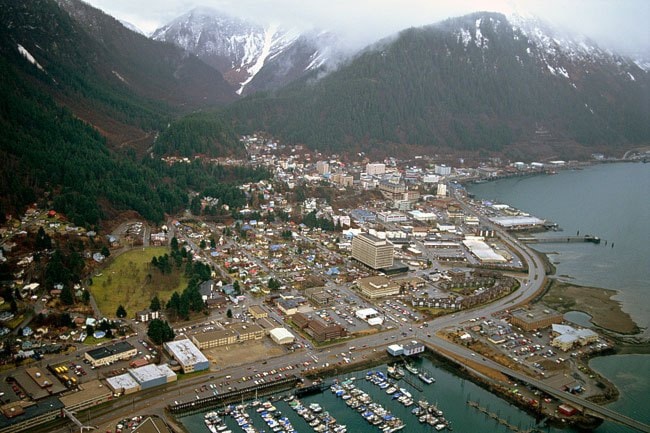Heavyweight boxer George Chuvalo might have lost 18 fights over the course of his career but no one was ever able to knock him down.
If the Juneau Access Improvement Project were a boxer, it would be George Chuvalo.
The plan to connect the state capital to the rest of the state’s highway system has been kicking around for 20 years.
It’s been battered and bruised by court decisions, budgetary shortfalls and community objections, but just like Chuvalo, it keeps coming back.
In January the push for a road started anew.
Now the state is reaching out to the public to get its opinion on the project.
“We’re collecting comments from people about what they think is important to be studied,” said Reuben Yost, the project manager for the Juneau access project.
“It’s been a fairly contentious issue,” said Yost.
While opinion in Juneau is split almost evenly on the project, smaller communities like Haines and Skagway, are opposed to it.
“It’s seems like one of those things that they’ll just debate forever,” said Jeff Brady, editor and publisher of the Skagway News.
Reopening the debate is not something the community is looking forward to,” he said.
“They don’t want to go through this again,” said Brady. “It gets people riled up. They get quite emotional about it.”
While the road is a complex and divisive issue, it’s not one that can be pigeon-holed to a simple right-versus-left political debate.
“It crosses all political stripes,” said Brady. “It’s not a liberal or conservative thing.”
While a lot of the opposition comes from the environmental impacts of a road, the price tag - approximately $470 million - of the project also raises the hackles of fiscal conservatives.
Another consideration, at least for Skagway, is the future of the port.
As the northernmost port on the Inside Passage, the possibility of losing that privileged position is another source of economic anxiety.
However, while the original plan was to build the road right into Skagway, under the most current incarnation of the project, the road, if it’s ever built, will stop well short of the town. It would end just north of the Katzehin River.
That’s because the entire town of Skagway exists inside a national historic site.
The final stretch is also an extremely expensive section of road to build, added Yost.
But that doesn’t mean that there will never be a road between Juneau and Skagway.
“The nice thing about this alternative is that it doesn’t preclude a hard link in the future; it just wouldn’t be accomplished as part of this project,” said Yost.
Building a connector road from Juneau to Katzehin is just one of several options under consideration.
This isn’t the first time that a road link has been considered.
It’s a project that was first proposed back in 1992.
Six years later it stalled after Tony Knowles, Alaska’s governor at the time, decided the project was too expensive.
In 2003 the idea was revived.
But in 2006 it hit a stumbling block. Several environmental groups sued the government in an effort to stop the project.
The plaintiffs argued the government had failed to consider the impact that building the road would have on sensitive wildlife habitat and the old-growth forest, and that alternatives to building the road were not properly considered.
On the last point U.S. District Judge John Sedwick agreed, ruling the government had erred in not properly considering things like upgrading the existing ferry service.
The government appealed the decision, but the Ninth District Court sided with Sedwick.
That left the government with two options - take the case to the Supreme Court or go back to the drawing board.
With the chances of the Supreme Court hearing the case slim at best, the government elected to start again.
“We’re hopeful but watchful about this new process,” said Dan Lesh, communications director for the Southeast Alaska Conservation Council, one of the lead plaintiffs in the 2006 lawsuit.
“We want to be involved in a healthy public debate,” he said. “The biggest issue is trying to make sure that it is based on a nonbiased process of analysis.”
Proponents of the project assert that building a road, even if it stops at Katzehin, will significantly cut down on both travel time and costs for area residents.
Travelling from Skagway to Juneau by ferry takes nine hours and costs $500 for a family of four.
With a road, that same trip would only take 2.5 hours and cost 80 per cent less, said Yost.
However, opponents of the project take issue with those numbers.
“They’re pie-in-the-sky assumptions,” said Lesh.
With more than 36 identified avalanche zones along the way, high maintenance costs and frequent delays are likely, he said.
But it’s not only an issue of cost but of safety, said Lesh.
“From our perspective, a lot of the money would be better spent improving our ferry service.”
The deadline to comment on the project is Feb. 20. Those comments will be used to produce a report which will be used to inform the Supplemental Environmental Impact Statement.
Yost hopes to have that done by the end of the year. Right now the tentative schedule calls for public meetings in Juneau, Skagway, Sitka and Haines in early 2013, with a decision document at the end of that year.
Contact Josh Kerr at
joshk@yukon-news.com
